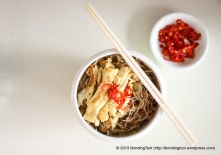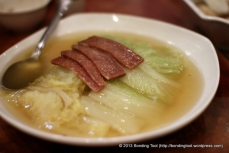Why Bother Making Fresh Pasta?
Why the heck would anyone bother making pasta from scratch when it’s just a box away? If you are as puzzled as I was, it’s time for us to get fresh!
Fresh and Dry pastas can be contradistinctive depending on its applications.
Most domestic packaged dry pasta do not contain eggs. Its two ingredients, durum wheat flour and water, are mixed, shaped, and then dried at low temperatures for optimal shelf life. Not only is dry pasta more convenient than fresh pasta, its denser, firmer texture can brave longer cooking times and holds up splendidly under heavy, hearty sauces.
Au contraire, a typical Italian-styled fresh pasta is made from a combination of eggs and wheat flour. Fresh pasta is desired for its delicate texture, luscious yellow complexion, and alimentative eggy-sapor.
Whole eggs have a long nutritional history of being good for you, then bad for you (during the low-cholesterol craze), and then good for you again. I believe eggs are a great source of a complete-high-quality-protein with fewer calories than other food source. My motto is “everything in moderation” but then again, more yolks will deliver more colour, more egg flavour, and velvety noodles! Hahaha… Aiyah, just eat and be nourished la!
Basic Egg Pasta Dough (serves 8-12)
500g Soft Wheat Flour “00”.
5 Whole Eggs (each approx. 60g with shell).
Pinch of fine Salt, optional.
A small amount of Water, if dough turns out too dry.
More Flour for dusting.
To obtain a better pasta, use a mixture of 250g of ground wheat flour and 250g of hard wheat flour (semolina – durum wheat flour).
What is “00” flour? It is Italian-milled flour that is used for pasta making. Italian flour is graded by colour (technically called extraction rate – that is the extent to which the bran and the germ are extracted from the flour). The labels Tipo “00” – “04” refers to the fineness of the milling. Tipo “00” is the finest grade of flour milled in Italy and has a texture consistency similar to baby talcum powder and 04 is rather closer to wholemeal.
And while most, if not all, pasta dough recipes call for “00” flour, I’ve used plain flour , and it works for me. Maybe I’m not that picky? Basically, if you have it or can get it (“00”), use it. If not, plain flour is fine!
Method:
Kneading The Dough By Hand (gives you more control):
On a clean work surface, pour flour in a mound. Make a well in the center and crack whole eggs [and purée (see variations below) if using], and salt (if using) into the well. Using a fork, beat the eggs (and salt) thoroughly. When combined, gradually incorporate flour into the eggs until a wet, sticky dough is formed. You may want to do an autolyse at this stage (see Tips below).
Remove excess dough from fork and fingers. Using a dough scraper, fold in additional flour into the dough, turning the dough roughly 45° each time, until the dough feels firm and can form a rugged ball, about 5 minutes.
Press the heel of your hand into the ball of dough, pushing forward and down. Rotate the ball 45° and repeat. Continue until dough develops a smooth, elastic texture similar to a modelling clay. If dough feels too wet, add flour in one teaspoon increments. If dough feels too dry, add water slowly using a spray bottle. The dough is at perfect consistency when it does not stick to your fingers.
Wrap the ball of dough with plastic, cling wrap or cover with a large mixing bowl and rest on countertop for 30 minutes or more, to relax the gluten.
Rolling The Pasta:
1. Meanwhile, place a sheet of parchment paper on a tray or cutting board and dust lightly with flour. Unwrap rested dough and cut into eight pieces.
2. Set one pice of the dough on work surface and re-wrap remaining 7 dough pieces. With a rolling pin, flatten the dough into a rectangular shape about half inch thick.
3. Set pasta maker to widest setting and pass dough 3 times through the machine at this setting.
4. Place dough on a lightly floured work surface. Fold both ends in so that they meet at the center of the dough, and then where the end points meet, fold the dough in half again. Using the rolling pin, flatten the folded dough to half an inch thick. Pass through the rollers for another 3 times.
5. Narrow the setting by 1 notch and repeat Step 4. Repeat once more – the dough should now have passed through the third widest setting. Continue passing the dough through the rollers, reducing the thickness by 1 setting each time until it reaches the desired thickness. It should now be very delicate and elastic to the touch, and slightly translucent.
6. Place the rolled dough onto the work surface or a baking sheet that has been lightly dusted with flour or lined with parchment paper, folding the dough over as necessary so that it fits; sprinkle with flour or line with parchment paper between folds to prevent sticking.
7. Cover dough with plastic wrap or a kitchen towel to prevent drying, then repeat Steps 2 through 6 with remaining dough pieces. Cut dough into 1o- to 12-inch length segments.
Cutting The Pasta:
Adjust pasta machine to noodle setting of your choice. Working one dough segment at a time, feed dough through the pasta-cutter. Alternatively, cut folded dough by hand with a chef’s knife to desired noodle width.
Divide the cut noodles into individual portions, dust lightly with flour, and curl into a nest-like bundle. Place on parchment-lined rimmed baking sheet and gently cover with kitchen towel until ready to cook.
Cooking The Pasta:
Bring a large pot of salted water to a rolling boil. Add pasta, stir gently with a wooden spoon, chopsticks, or a cooking fork, and cook, tasting at regular intervals until noodles are just set with a definite bite, about 1½ to 2 minutes, longer if you like softer bite. Drain, toss with sauce, and serve.
There are so many flavours you can add to the basic pasta dough. Can you guess my favourite coloured pasta?
Variations: (guidelines – adjust amount of purée to your desired hue intensity and personal taste preferences)
Green Pasta (Spinach Purée)
150-300g Spinach – washed and boiled for 10 minutes. Bring a large pot of water to a boil. Meanwhile, fill a large bowl with cold water and ice. Add rinsed and trimmed spinach and cook 5 minutes. Drain and plunge spinach into bowl of iced water. When spinach is cold, drain and squeeze dry. Purée until smooth.
Orange Pasta (Carrot Purée)
150-300g Carrots – peeled, thinly sliced and boiled for 15 minutes. Purée until smooth. OR
150-300g Butternut Squash – roast till tender purée until smooth.
Red Pasta (Beet Purée)
150-300g Beets – rinsed and trimmed beets. Boil in a large pot of water until easily pierced with a fork, approximately 40-45 minutes. Drain and let cool. Peel beets and purée until smooth.
Salmon-Pink Pasta (Tomato Purée)
6-12 tablespoons (1 tbsp is 15g) Concentrated Tomato Paste.
Black Pasta (Squid Ink)
6-10 teaspoons Squid Ink.
More Variations:
Wholemeal Pasta
500g Soft Wheat Wholemeal Flour
250ml Water
Eggless Pasta (Vegan)
500g Soft Wheat Flour/Semolina Flour
250ml Water
Gluten-free Pasta
300g Buckwheat Flour
2 Whole Eggs
125ml Water
Vegan Recipe see video below:
Storage: (Drying/Freezing Fresh Pasta)
Hang prepared (rolled out and cut) pasta onto noodle/pasta drying rack for a few hours or until completely dry (can take up to a couple of days, depending on temperature and humidity). Keep for a month in air-tight jars on countertop away from direct sunlight.
Pasta can also be frozen directly on the baking sheet, transferred to ziplock freezer bags, and stored in the freezer for up to three weeks before cooking. Cook the frozen pasta directly out of the freezer.
Tips:
Do not use cold eggs straight from the fridge. Let them come to room temperature.
Using a higher ratio of egg yolks to egg whites produces exquisite, full-bodied classic Italian flavour and texture. You may want to add a couple more yolks to the recipe and adjust flour when kneading.
A great pasta dough is smooth and pliable but should never stick to your hands. If they do, add more flour. If dough is too dry, spray a little water onto the dough at a time and knead well. The dough is at perfect consistency when it does not stick to your fingers.
Adjust your flour for about 53% hydration. Basically, you just need to measure the eggs first: take the weight of eggs in grams, and divide by 0.53 to get the total grams of flour. This should get you pretty close to an ideal mixture without much need for adjustments.
Autolyse: If you have the time, you might want to try doing a 20 minute autolyse (especially useful if using half and half APF and Semolina Flour) – bring the dough together to a ball, then let it sit for 20 minutes before attempting to knead. Semolina makes the dough harder to knead, and the autolyse helps move along the hydration of the flour. Initially, it may feel like a brick, but it gets easier after a couple minutes of kneading. Rest the dough long enough (may take a few hours) at room temperature, to achieve a pliable soft consistency.
Pasta lengths should be roughly 25cm (10 inches) long. This recipe can be used for making lasagna, ravioli and tortellini, too.
Always cook pasta in large pot of salted water that has been brought to a fast boil. Cook for 2-4 minutes (depending on its thickness) till al dente. Dried pasta needs about 4-6 minutes.
Stir gently and drain out pasta (keeping a cup of pasta water for later use if necessary). Add cooked pasta to your desired sauce base and toss well to combine. Serve on warmed plates.
Pasta Machine Troubleshoot:
You can roll out (rolling pin) and cut the pasta by hand (knife) or a pizza cutter to slice the dough into strips, and if you have the equipment, by using the pasta maker machine. More flour will be used during this process.
If the rollers are not able to “cut”, it means the pasta sheet is too soft. Add some flour.
If the dough is too dry, the rollers cannot “grip” or take in the pasta sheet. Add a little water and knead the dough before feeding through the smooth rollers again.
Never wash your pasta maker machine. Follow the maintenance instructions from the manufacturer. Many problems can be solved by spending a few minutes on the manual.
So why bother with making fresh pasta? Fresh home-made egg pasta is packed with flavour and nutrition because of the good egg! Its fascinating silky texture makes everything landed on it, sing!
Good Pasta Needs Only A Simple Sauce
“Fettuccine Alfredo or fettuccine al burro is a pasta dish made from fettuccine tossed with Parmesan cheese and butter. As the cheese melts, it emulsifies the liquids to form a smooth and rich sauce coating on the pasta.
Origin: Italy
Main ingredients: Fettuccine, Parmigiano-Reggiano, Butter.” – Wikipedia
Effortless Alfredo Sauce Ingredients:
600g fresh Fettuccine.
1 tablespoon Sea Salt, plus ½ teaspoon more for sauce.
125g grated Parmigiano-Reggiano (or Pecorino Romano), plus extra for serving.
80g-100g Unsalted Butter.
3 quarts Water.
Although Parmigiano-Reggiano is the original choice, Pecorino Romano seems to be popular with those looking for stronger flavour in pasta.
Method:
1. In a large pot, bring 3 quarts water and 1 tablespoon sea salt to a fast boil. Add fettuccine and cook, stirring frequently, until al dente. Turn off heat. Reserve 1 cup of the pasta-cooking water and drain the rest away with a colander in the sink. Return strained fettuccine to pot.
2. Add Parmigiano-Reggiano (or Pecorino Romano), butter, reserved pasta water, and ½ teaspoon salt to the fettuccine in the pot. Set pot over low heat on the stove and toss the ingredients vigorously to thoroughly combine, about 1 minute. Remove pot from heat, cover, and let pasta sit for 1 minute.
3. Uncover and toss pasta vigorously once more for about 30 seconds, so that the sauce thoroughly coats pasta and any cheese clumps are emulsified into sauce. Do not worry if the mixture may look wet at this point, because the pasta will absorb excess moisture as it cools slightly. Season with freshly milled black pepper and more salt to taste.
4. Transfer pasta to individual warmed bowls. Serve immediately, passing extra Parmigiano-Reggiano (or Pecorino Romano) around the table.
Enjoy!
You should be able to guess by now that I love squid ink a.k.a. black pasta!
P.S. I will still buy reasonably priced and reliable brands like Barilla, De Cecco and Naturel! My pantry is seldom without pasta and canned tomatoes.
Happy cooking, eating and bonding! 🙂
Other Fresh Pasta Recipe:
JAMES MARTIN’S DECADENT HOMEMADE LINGUINE WITH LOBSTER SAUCE RECIPES

































